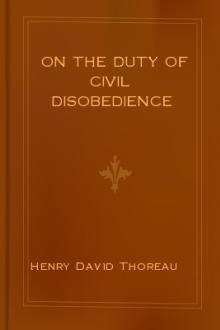Essays - Henry David Thoreau (best e reader for android .TXT) 📗

- Author: Henry David Thoreau
Book online «Essays - Henry David Thoreau (best e reader for android .TXT) 📗». Author Henry David Thoreau
The bars along the coast shift with every storm, and in many places there is occasionally none at all. We ourselves observed the effect of a single storm with a high tide in the night, in July, 1855. It moved the sand on the beach opposite the lighthouse to the depth of six feet, and three rods in width as far as we could see north and south, and carried it bodily off no one knows exactly where, laying bare in one place a large rock five feet high which was invisible before, and narrowing the beach to that extent. There is usually, as I have said, no bathing on the back side of the Cape, on account of the undertow; but when we were there last, the sea had, three months before, cast up a bar near this lighthouse, two miles long and ten rods wide, over which the tide did not flow, leaving a narrow cove, then a quarter of a mile long, between it and the shore, which afforded excellent bathing. This cove had from time to time been closed up as the bar travelled northward, in one instance imprisoning four or five hundred whiting and cod, which died there, and the water as often turned fresh and finally gave place to sand. This bar, the inhabitants assured us, might be wholly removed, and the water be six feet deep there in two or three days.
The lighthouse keeper said, that, when the wind blowed strong on to the shore, the waves ate fast into the bank, but when it blowed off, they took no sand away; for in the former case the wind heaped up the surface of the water next to the beach, and to preserve its equilibrium a strong undertow immediately set back again into the sea, which carried with it the sand and whatever else was in the way, and left the beach hard to walk on; but in the latter case the undertow set on, and carried the sand with it, so that it was particularly difficult for shipwrecked men to get to land when the wind blowed on to the shore, but easier when it blowed off. This undertow, meeting the next surface-wave on the bar which itself has made, forms part of the dam over which the latter breaks, as over an upright wall. The sea thus plays with the land, holding a sandbar in its mouth awhile before it swallows it, as a cat plays with a mouse; but the fatal grip is sure to come at last. The sea sends its rapacious east-wind to rob the land, but before the former has got far with its prey, the land sends its honest west-wind to recover some of its own. But, according to Lieutenant Davis, the forms, extent, and distribution of sandbars and banks are principally determined, not by winds and waves, but by tides.
Our host said that you would be surprised, if you were on the beach when the wind blew a hurricane directly on to it, to see that none of the driftwood came ashore, but all was carried directly northward and parallel with the shore as fast as a man can walk, by the inshore current, which sets strongly in that direction at flood-tide. The strongest swimmers also are carried along with it, and never gain an inch toward the beach. Even a large rock has been moved half a mile northward along the beach. He assured us that the sea was never still on the back side of the Cape, but ran commonly as high as your head, so that a great part of the time you could not launch a boat there, and even in the calmest weather the waves run six or eight feet up the beach, though then you could get off on a plank. Champlain and Poitrincourt could not land here in 1606, on account of the swell (la houlle), yet the savages came off to them in a canoe. In the Sieur de la Borde’s Relation des Caraibes, my edition of which was published at Amsterdam in 1711, at page 530 he says:—
“Couroumon a Caraibe, also a star [i.e. a god], makes the great lames à la mer, and overturns canoes. Lames à la mer are the long vagues which are not broken (entrecoupées), and such as one sees come to land all in one piece, from one end of a beach to another, so that, however little wind there may be, a shallop or a canoe could hardly land (aborder terre) without turning over, or being filled with water.”
But on the bay side, the water, even at its edge, is often as smooth and still as in a pond. Commonly there are no boats used along this beach. There was a boat belonging to the Highland Light, which the next keeper, after he had been there a year, had not launched, though he said that there was good fishing just off the shore. Generally the lifeboats cannot be used when needed. When the waves run very high, it is impossible to get a boat off, however skilfully you steer it, for it will often be completely covered by the curving edge of the approaching breaker as by an arch, and so filled with water, or it will be lifted up by its bows, turned directly over backwards, and all the contents spilled out. A spar thirty feet long is served in the same way.
I heard of a party who went off fishing back of Wellfleet some years ago, in two boats, in calm weather, who, when they had laden their boats with fish, and approached the





Comments (0)